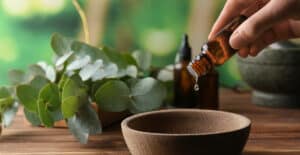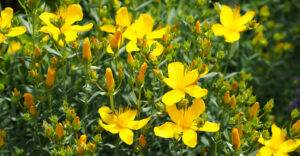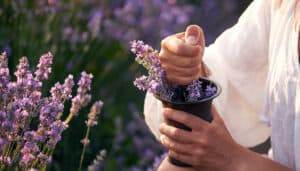The immune system is truly remarkable. Day in and day out, it works to protect us against pathogens, keep immune cells in check, and does its best to regulate our internal environment. It is a highly intelligent, complex, and intricately coordinated system.
However, as we’ve all experienced, there are times when it needs a bit of a boost; some external assistance to help it perform its many functions. Medicinal herbs have much to offer when it comes to immune health. They can strengthen, regulate, and stimulate the immune system depending on the need, and the herb in question. The following immune herbs can greatly benefit us in times of sickness and help to prepare our bodies for potential infection.
Considerations Before Modulating Immune Function with Herbs
That said, there are some important things to address before diving into the top herbs to boost the immune system. First, it’s imperative to understand that herbs work alongside our body’s functions – augmenting the natural processes already occurring. Medicinal plants are allies to our health, and so we must be as well.
If you seek to strengthen and regulate your immune system, herbs are just one pillar in the foundation of vital health. If you feel yourself coming down with something, the first step is to address why that is and what other factors may be affecting your immune system’s ability to ward off sickness. Nutrition, sleep, stress, and hydration directly affect our immune system, and when these elements of health are neglected, they can cause us to be susceptible to harmful pathogens.
The first steps to boosting your immune system are to rest, relax, drink plenty of fluids, and eat healthy, whole foods that nourish your body. If you implement these steps along with support from herbal medicine, you are supporting your immune system in a truly holistic manner.
11 Herbs to Boost Immunity
The following list includes popular immune-boosting herbs you’ve probably heard of, as well as unique allies you’ll love to become acquainted with. Not all the herbs on this list are immune stimulating or “boosting,” but are an important addition to this list as they work to strengthen and build the immune system on a deeper level. These herbs are called tonics and are taken over a long period of time rather than at the onset of illness.
As you go through the list, I invite you to feel what herbs call to you and your current needs. If any of them stand out to you, I encourage you to look more into their medicine and proper use. Lastly, before we dive in, it’s important to talk with a qualified herbalist or healthcare professional before ingesting any herb. This article is not intended to give medical advice; rather, it’s a helpful guide for some useful allies you can call upon in times of need.
Elderberry (Sambucus nigra)
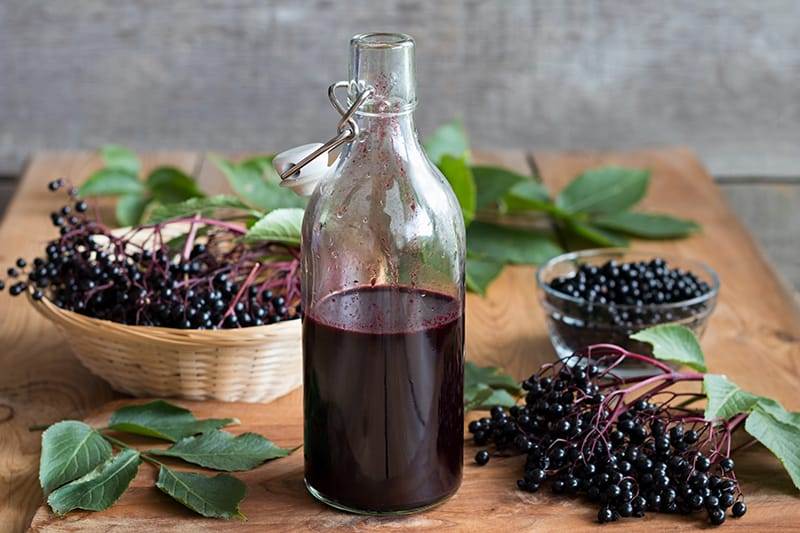
Elderberry is one of my favorite, most trusted medicinals. It is by far my top choice for immune-boosting herbs, as it’s safe, reliable, and powerful. As soon as I feel that my immune system needs some support, I first turn to the aid of elderberry, along with some of her wise sisters; calendula and yarrow.
The flowers and berries of Elder are used for medicine, and both can be used for respiratory infections, such as the cold or flu.
The berries are antiviral, immune-stimulating, and are an immune tonic (among other medicinal actions). The berries have proven to have powerful antiviral properties, and multiple studies have shown the berry’s ability to directly inhibit the influenza virus from entering and replicating human cells. Thus, elderberries can be used at the first sign of sickness and throughout the duration of a cold or flu. Consistent use of elderberries throughout sickness can shorten the duration of illness and help with symptoms such as fever, congestion, inflammation, and headaches.
Elderberries have traditionally been used as an immune tonic, which means they are an effective, long-term remedy for strengthening and building the immune system. You can use elderberry this way by taking a tea, tincture, or spoonful of elderberry syrup consistently throughout the colder months when infections run rampant. You can also call on the aid of elderberry if you feel you have a weak immune system and are constantly getting bogged down with infections.
The flowers are a powerful and effective diaphoretic, meaning they help the process of a fever by encouraging perspiration and relaxing tension. They also decongest the sinuses and cool heat/irritation in the upper respiratory tract. To use elderflowers during a fever, it’s best to take them as a hot infusion (tea), as the hot water will also work as a diaphoretic to bring on perspiration and help to release trapped heat.
The berries are best taken as a syrup, tincture, or decoction. A decoction is simmering an herb on the stove for an extended period (low simmer for 30 min to several hours). If you would like to make a decoction of the berries, use dried berries, as the fresh berries contain constituents called cyanogenic glycosides (CGs) that cause intense nausea, vomiting, and diarrhea in moderate doses. The CGs break down and become ineffective when the berries are dried, cooked, or tinctured. Even though it’s powerful, elderberry is still a gentle remedy and is safe for children. Plus, it tastes delightful, so it’s an easy medicinal to administer.
This is truly just the tip of the iceberg when it comes to the medicinal virtues of Elder, and its powerful gifts extend beyond just the immune system. If you feel called to start taking elder as a medicine, I suggest finding a reliable herb book and learning more about its amazing medicinal value. In folklore, it’s seen as a wise elder (hence the name) and was honored for the gifts it gave to the people. In this way, Elder has been used medicinally for centuries and is one of the top medicinal herbs to become familiar with.
Ginger (Zingiber officinale)
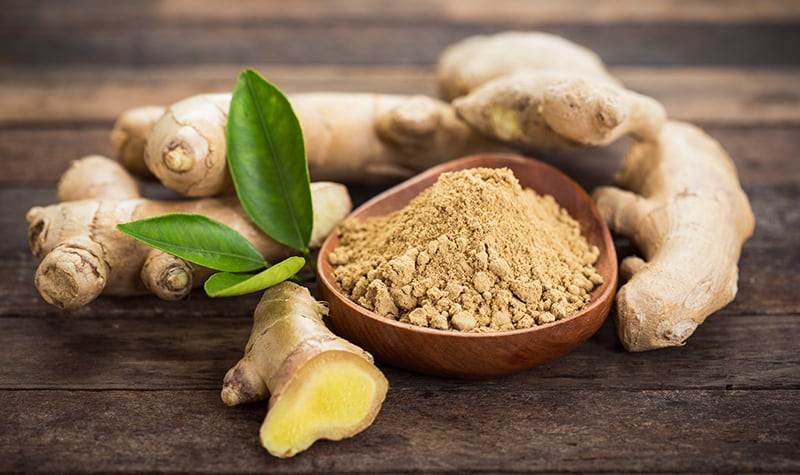
Warming and pungent, ginger stimulates the immune and circulatory systems and is used as an antiviral agent. Thus, it is a useful aid for fevers, colds, and flu. Ginger is a traditional Ayurvedic and Chinese medicine herb, and Chinese studies show ginger helps kill the influenza virus through its antiviral properties.
In the case of a fever, ginger is best used during the first phase of a fever when one is cold with chills, feels lethargic, and has pale skin. During this phase, the heat is trapped and isn’t circulating out to the skin/periphery. Ginger helps circulate the blood, brings warmth to the body, and pushes the internal heat out towards the skin. This can help someone warm up and feel better during the initial stages of a fever. However, because fevers tend to alternate between chills and feeling hot, it’s best to combine ginger with other diaphoretic herbs, such as elderflower, yarrow, and peppermint for this purpose.
Along with its immune properties, ginger is a wonderful herb for stimulating digestion, easing cramps, enhancing circulation, lowering blood pressure, and lowering cholesterol. It’s a traditional and reliable remedy for nausea and morning sickness, though it should be taken in low doses during pregnancy.
As you can see, ginger is quite a useful little herb, and there are many ways to incorporate it into daily life. It can easily be added to food as a spice or added fresh to a smoothie. It can also be taken as a warming and comforting tea. As a pleasant and aromatic spice, you can make all sorts of delightful baked goods with ginger, such as gingerbread or ginger snap cookies.
The only caution I would give to using ginger as a daily tonic is it can aggravate those who run hot, especially in their digestive system. Other than that, ginger is a safe remedy that has been used as a traditional medicine for centuries.
Garlic (Allium sativum)

It’s no wonder that garlic has become a kitchen staple and is a prized ingredient in many recipes. Not only does it add a pungent and distinct taste to meals, but it is also a highly valued medicinal with impressive antibacterial, antiseptic, and antiviral properties.
In his book, Holistic Herbal: A Safe and Practical Guide to Making and Using Herbal Remedies, herbalist David Hoffman writes, “Garlic should be thought of as a basic food that will augment the body’s health and protect it in general . . . it may be used as a preventative for most infectious conditions, digestive as well as respiratory.”
In the digestive tract, garlic works extraordinarily: it directly kills pathogenic or harmful bacteria while also improving the environment for beneficial bacteria to thrive. It uses an intelligent process to differentiate harmful pathogens from beneficial bacteria. Matthew Wood writes, “This has led to its successful use killing intestinal parasites and bacteria while reestablishing the healthy flora of the colon.”
Garlic can be used for infection, whether that be viral or bacterial. It has been used traditionally as an effective ear infection remedy; a few drops of the oil can be dropped into the ear canal. To fight infection, garlic is best used fresh, and whole cloves can be taken raw or used in food. As a food herb, it can be used as a daily tonic to build immunity and improve bodily functions, such as metabolism, digestion, and circulation.
As with ginger, garlic is warming and pungent and may aggravate hot constituents in higher doses or if taken too long. Garlic is a multilayered and complex herb with many beneficial uses. As with elderberry, I encourage you to learn more about its extraordinary uses if you feel called to incorporate its medicine.
Oregano (Origanum vulgare)
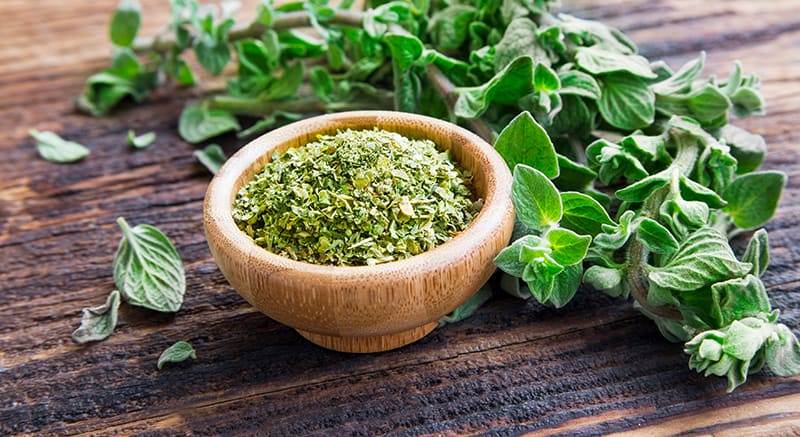
As a familiar culinary herb, Oregano is a staple in most kitchens throughout the United States and worldwide. Its pungent, warming properties and high essential oil content lend its traditional use as an immune system stimulant. In its concentrated forms, such as oil or essential oil, Oregano has demonstrated antiviral and antifungal properties through its volatile oils (carvacrol and thymol).
Oregano oil can be used topically for fungal conditions, such as ringworm or athlete’s foot. Because it has an affinity for the respiratory system and antimicrobial properties, the diluted essential oil can be inhaled during colds and flu.
For this purpose, get a large bowl of just boiled water and add a few drops of oregano essential oil to the steaming water. You can also add other immune-enhancing/antiseptic essential oils such as tea tree, peppermint, and lavender. Then, place your head above the bowl, cover yourself with a towel so the steam doesn’t escape, and inhale the vapors. This will help clear your sinuses and allow the vapors to come into direct contact with the infection.
Olive Leaf (Olea europea)

Olive leaf is rich in history and tradition, and its use can be dated back as far as the ancient Egyptians. While the leaf was a traditional medicine in ancient history, it has just recently been reintroduced as a viable and modern medicine for the immune system.
Matthew Wood shares in The Earthwise Herbal, Volume 1, “It (olive leaf) has remarkable properties as an antiviral, antibiotic, antifungal, and antiparasitic. It can kill or inhibit more than one hundred pathogenic microorganisms . . . (including) chicken pox, common cold, influenza, strep, pneumonia . . .(among many others).”
Olive leaf contains constituents called tannins that tighten and bind tissues. The medical term for this action would be astringent. Thus, olive leaf is a useful remedy for sores and wounds as it disinfects the area, prevents infection, and promotes tissue healing.
Reishi Mushroom (Ganoderma lucididum)

Deemed the “mushroom of immortality” by the ancient Chinese emperors and healers, reishi is a powerful medicine that readily lends its gifts to those in need. It’s been referred to as an herbal panacea due to its incredible effects on the different systems in the body. Reishi is an adaptogen, which is an herbal action term that describes plants that regulate, relax, strengthen, and bring balance to the whole body. As an adaptogen, it has a specific and profound effect on the immune system.
Rather than stimulating the immune system, reishi works as an immune tonic or immunomodulator. It brings balance to the immune system, whether there is a deficiency or hyperactivity, as in the case of autoimmune conditions. In this way, reishi is best used to “boost” one’s immune system when one is feeling well rather than at the onset of sickness. In other words, reishi can be used daily as an immune tonic to regulate and strengthen one’s immunity which will ultimately protect one from illness.
Herbalist Sajah Popham writes, “Reishi is best understood as an immune tonic acting deeper on the immune system, used to strengthen the vital reserve and build up core immunity- rather than superficially stimulating the peripheral immune system.”
You may be wondering how an herb can work in a seemingly paradoxical way, as in how is reishi able to strengthen a deficient immune system AND regulate a hyperactive immune system? This effect is due to polysaccharides called beta-glucans that can adjust their effect depending on the need of the body – such as increasing white blood cell production or suppressing hyperactive immune cells.
Reishi has been shown to possess anti-carcinogenic properties and is a useful adjunct therapy to modern cancer treatment. It can also be used for allergies, mental and nervous system disorders, liver deficiency, and heart problems. As you can see, there is much that reishi has to offer, and it is a valuable medicinal mushroom to become acquainted with.
The dried fruiting body of reishi is best taken as a decoction as the polysaccharides are best extracted in water. That said, a dual extraction (both alcohol and water) is another easy and simple way to take reishi as a daily tonic. Reishi can be quite bitter so getting your hands on a high-quality dual-extracted reishi tincture is the way to go. That said, you can also make a nourishing and immune-building broth with reishi (and other good-tasting herbs to mask the bitterness).
Astragalus (Astragalus propinquus)
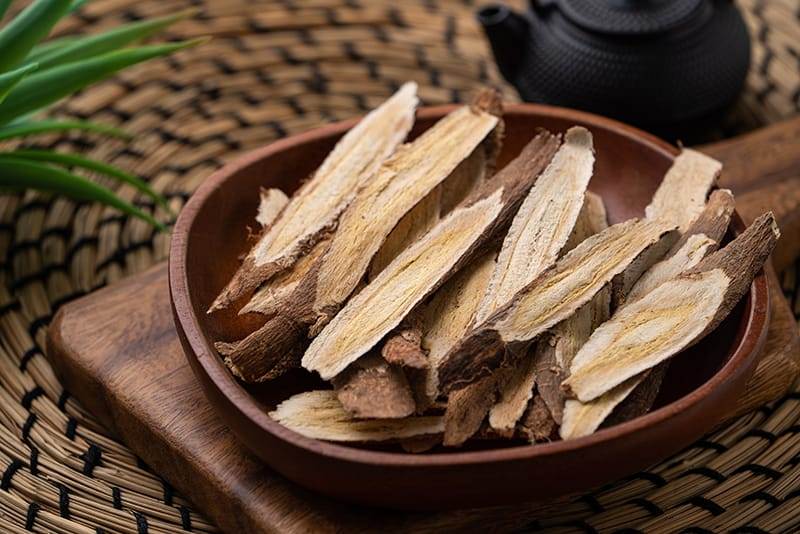
Astragalus is a famous and well-used Traditional Chinese Medicine herb that has become popular in western herbal medicine. This is due to its adaptogenic qualities, and its impressive affinity for the immune and respiratory systems.
Like reishi, astragalus is a deep-working immune tonic. It doesn’t stimulate the immune system; rather, it builds a deficient, malnourished, and weak immune system. In fact, in Traditional Chinese Medicine, it’s an herb that tonifies (strengthens and builds) the Wei Chi, which is described as the protective energy (skin and periphery) around the body. In this way, it strengthens the immune system and protects it from invading pathogens. It’s quite powerful in this action and closes the pores of the skin and decreases excess sweating.
This is an important quality to understand about astragalus, as this isn’t an herb you would want to use during acute infection, especially associated with fever. During a fever, when your body is working to “cook” and kill the pathogen, the pores of the skin need to be opened to allow heat to escape from the body’s core. Astragalus would prevent the heat from escaping and potentially cause the pathogen to move deeper as it closes the outer layer of the body (keeping things trapped as well as preventing things from entering).
Astragalus is best used as an immune tonic in cases of weak and deficient immune systems and poor nutrition. It builds the tissues of the body and the digestive tract for the body to properly absorb nutrients from food. Astragalus is especially indicated if there is poor/weak immunity associated with the respiratory tract. This would be the case if you get sick often and the area infected is the respiratory tract, as is the case with colds and flu.
You use the root of astragalus, and the best preparation method is decoction or using it in soup broths. It has a pleasant “beany” flavor and is a traditional food herb used in soup stocks in Asia.
Calendula (Calendula officinalis)

Calendula is one of my favorite go-to herbs. Its sunny disposition makes it a lovely addition to tea blends, smoothies, and salads. It’s versatile in its uses and is a great ally for the immune system – before, during, and after sickness.
Calendula is, first and foremost, an alterative with an affinity for the lymphatic system. As an alterative, it cleanses and detoxes bodily fluids, specifically the blood and lymph. As a lymphagogue, it moves the lymphatic fluid, releasing stagnation and clearing cellular debris and waste products. These actions, along with its antifungal, antibacterial, and antiviral properties lend its use as an herb for the immune system.
Calendula can be used as a daily tonic to support the immune system by keeping the lymphatics healthy and clear, which directly affects the immune system. During a cough, cold, flu, and associated fever, it helps the immune system fight the infection by keeping the lymph moving and through its antiviral/antibacterial properties. After an illness, when the body is recovering and trying to remove the waste products accumulated during sickness, calendula will support this process by decongesting and detoxifying the lymphatics. It is especially indicated for swollen and hard lymph nodes.
Calendula’s claim to fame came about through its amazing wound-healing properties. Calendula can be used topically for cuts, scrapes, burns, rashes, bruises, and sores. Its antiviral, antibacterial, and antifungal properties will help clean the wound, prevent infection, and promote tissue repair.
There are several ways you can use calendula, and it is an incredibly safe and gentle remedy. I think of it as a great “gateway herb” into the world of herbal medicine as it’s easy to incorporate into teas, tinctures, salves, oils, and food.
Spilanthes (Acmella oleracea)

Also known as toothache plant, spilanthes is an effective immune stimulant that can be used for viral, bacterial, and fungal infections. It stimulates white blood cell production and augments the body’s natural defenses against invading pathogens.
Spilanthes can be used when one is exposed to an infectious illness or when traveling during the cold and flu season to help boost one’s immunity. It is effective against the cold and flu virus, as well as urinary tract infections, sinus and ear infections, cold sores, vaginal and yeast infections, viral meningitis, and bacterial infections on the skin.
As the name implies, spilanthes has been traditionally used for toothaches and infections and to maintain healthy gum tissue. When chewing the fresh flower, a distinct tingling and numbing sensation fills the mouth. This sensation is due to the active components known as alkylamides, which are responsible for spilanthes’ immune-stimulating properties. Alkylamides are also found in echinacea and prickly ash.
Spilanthes is best used fresh, as the dried preparation tends to be less chemically active (specifically the alkylamides). Spilanthes can be taken as a tincture or fresh tea. The tincture or fresh tea can be used as a mouthwash to protect the teeth and gums and prevent decay or disease.
As with most immune stimulants, spilanthes should be taken acutely and not for an extended period of time. Rather it should be used at the onset of illness, when exposed to infectious diseases, and throughout an infection. It can be used with antibiotics to augment their effect, and this is especially helpful when dealing with bacteria that have built resistance to antibiotics, such as Staphylococcus aureus (MRSA).
Echinacea (Echinacea purpurea)
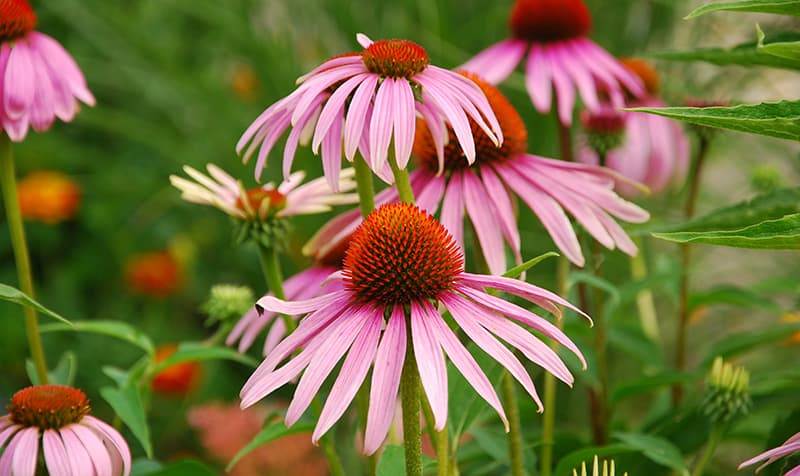
Echinacea may be the most popular immune-boosting herb on the market. While it is powerful in its antiviral and antibacterial properties, controversy over its proper use amongst herbalists is prevalent.
This is because some herbalists believe echinacea is inappropriately used to suppress symptoms of the cold or flu when its traditional use has been for more serious conditions. Their argument is: rather than an individual listening to the wisdom of their body (feeling ill) and resting, drinking fluids, and eating nourishing foods; the individual is taking high doses of echinacea to ward off sickness while still working too hard, feeling worn out and stressed, and not eating well. In this way, the symptoms are suppressed, but the root cause of the infection is not addressed, which eventually leads to disease.
In this scenario, echinacea isn’t the cure – the cold is the cure. What I mean by that is that the medicine isn’t an herb or a drug, rather it’s taking the time to rest, recuperate, and nourish the body.
I believe echinacea can be used in conjunction with nourishing support for the whole body. In this way, echinacea is quite effective for viral infections and can be taken at the onset of sickness.
Herbalist Steven Foster writes, “Echinacea enhances the particle ingestion capacity of white blood cells and other specialized immune system cells, increasing their ability to attack foreign invaders, such as cold or flu viruses. Echinacea products are best taken as the onset of cold or flu symptoms, when you first “feel like you are coming down with something.” Echinacea products are not recommended for continuous use as a “preventative” during the cold and flu season. Echinacea should be used only as needed.”
Goldenseal (Hydrastis canadensis)

As a popular antimicrobial herb, goldenseal is one of the most sought-after herbs in the market. Yes, it is a powerful and effective remedy that has its place when it comes to boosting the immune system. However, due to its popularity and market value, it has been sought after nearly to extinction. It is now listed on the United Plant Savers List as endangered and shouldn’t be purchased unless you can ensure the plant material is cultivated rather than wild-harvested.
Goldenseal is a traditional Native American plant that is a tonic for the digestive system and mucus membranes. It contains an active constituent, berberine, that yields its effective antimicrobial, antifungal, and anti-protozoan properties. Another active constituent, hydrastine, is what makes goldenseal a wonderful aid for excessive mucus production, especially in the sinuses and upper respiratory system.
Although popular, herbalist Matthew Wood denotes goldenseal as one of the most overused herbs in commerce today. That may be because it has been inappropriately used as a go-to remedy for colds and flu. In the book, The New Healing Herbs by Michael Castleman, he states, “Because goldenseal treats so many infectious diseases, some herbalists have recommended it for colds and flu . . . However, there is no evidence that goldenseal is effective against cold or flu viruses. In traditional herbal folklore, goldenseal was used almost exclusively as an oral treatment for digestive tract infections or topically for bacterial and fungal infections.”
Goldenseal is most appropriate when cold or flu symptoms move deeper into the body – when the mucus becomes thick, unmoving, and yellow-green. Goldenseal also has to make direct contact with the site of infection to be most effective. For the case of a sinus infection, for example, goldenseal is best used as tea in a neti pot. You can also combine a few drops of the tincture with a warm saline solution as a nasal flush for this purpose.
I wouldn’t suggest goldenseal as one of your go-to herbs to boost the immune system, rather it’s a powerful antimicrobial remedy that is useful for specific situations, such as upper respiratory infections, yeast infections, peptic ulcers, sore throats, and as a digestive aid. Because it’s overharvested, I would recommend using other herbs that also contain berberine that aren’t at risk, such as Oregon grape root (Mahonia aquifolium) and barberry (Berberis vulgaris).


